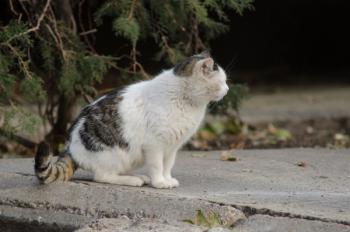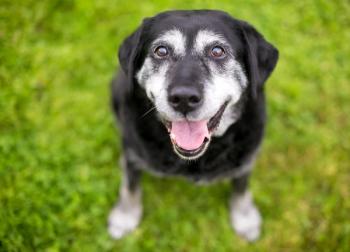
Infectious lameness control programs (Proceedings)
Foot rot is caused by specific pathogenic strains of Fusobacterium necrophorum and Bacteriodes melaninogenicus that gain entry through the interdigital skin.
Environmental risk factors for infectious causes of lameness
1. Foot rot is caused by specific pathogenic strains of Fusobacterium necrophorum and Bacteriodes melaninogenicus that gain entry through the interdigital skin. These bacteria can persist in wet soil or slurry for very long periods. They are also routinely present in the rumen and colon of cattle, although not necessarily pathogenic strains. Intact dry skin is resistant to penetration of these organisms. Thus, conditions that produce breaks in the interdigital skin such as coarse sand or small stones becoming lodged in the interdigital space by walking through mud may predispose to foot rot. These conditions might prevail in cattle laneways, around water sources, or in riparian zones. Traditional control methods have been to fence cattle away from riparian zones and mudholes. A new approach for cattle laneways that is in use in the United Kingdom was recently described by Dr. Roger Blowey from Gloucester. A 40 inch wide roadway is constructed by excavating to a depth of 12 inches. Eight inches of gravel or crushed stone is placed in the trench, covered with geotextile fabric and the remainder of the excavation filled with shredded bark. The laneway remains dry on the surface, stands up very well to traffic, and cows move quite comfortably along.
Foot rot in housed dairy cattle may be predisposed by the maceration of the interdigital skin which is continuously moist. The severity of problems in housed dairy cattle is dependent on manure removal practices which may influence both the infection pressure and the interdigital skin integrity. Footbathing with antibacterial compounds is a routine procedure to prevent new cases of foot rot.
2. Interdigital dermatitis is a chronic superficial infection of the interdigital skin caused by Dichelobacter nodosus. It is very common in housed cattle with visible lesions present in the majority of cattle, whether housed in freestalls or tiestalls. One reference indicates a lower incidence of lameness due to interdigital dermatitis on slatted floors than solid floors. Pain and lameness are not present in the most obviously infected cattle. Exposure to manure and urine predispose to infection and to the severity of problems. Most lameness due to interdigital dermatitis is secondary either to skin (and possibly hoof sole) hypertrophy or to fissures in the heel horn caused by the bacterial elastases that are capable of cleaving the beta-pleated keratin of the hoof. The main environmental risk factors seem to be manure contact with the skin and anaerobic conditions between the manure layer and the skin. Control is as for foot rot.
3. Digital dermatitis is an infectious disease of the skin affecting cattle older than about 6 months of age anywhere from the vicinity of the dewclaws distally. The causal organism(s) have not been conclusively identified but response to therapy with antibacterial drugs and the consistent observation of spirochetes in affected tissues supports a bacterial etiology. Environmental risk factors are the same as for interdigital dermatitis and the 2 diseases often occur together with some synergy apparent. Infection with Dichelobacter nodosus may facilitate establishment of the agents of digital dermatitis. Dry conditions as might occur in dry lot or some pasture conditions seem to prevent spread of the infection but do not influence the severity in already infected cattle. Control is with footbathing or spraying with the antibiotics (oxy)tetracycline or lincomycin. These plus some antiseptic solutions including formalin are used successfully in footbaths for control.
Foot Rot or Interdigital Phlegmon
Recognition of this acute disease is straightforward. The bacterial causes are Fusobacterium necrophorum and Bacteriodes melaninogenicus with both required for disease to occur. There may be other important bacterial contributors from the genus Prevotella. The cow becomes lame over the course of a day or two with symmetrical swelling above the hoof. Pain may be severe with unwillingness to bear any weight on the affected limb. Rear limbs are more commonly affected. There is a fissure in the interdigital skin with necrosis of the underlying tissues. Usually this is a dry necrosis with no exudate but some very virulent strains of F. necrophorum may produce tissue liquefaction. The odor of foot rot is strong and characteristic. Corrective claw trimming may be employed along with some topical antiseptic to the interdigital space. Bandaging is strongly discouraged so that air may reach the interdigital tissues. Parenteral antibiotics are the most important part of therapy. For almost all cases of foot rot many antibiotics are effective and the choice is unimportant. In the United States, as of this writing, ceftiofur is registered for foot rot and requires no milk discard. There are cases of foot rot caused by multiple-drug-resistant F. necrophorum. Trial and error has determined that these cases respond to treatment with tylosin at label recommended dosages. Recognition of the presence of drug resistant strains in a herd comes after treatment failure with the usual choice of antibiotic. It is important to verify that the actual disease problem is foot rot since many cases are diagnosed and treated by farmers or their employees. If the original problem was a sole ulcer, changing antibiotics will not help.
Interdigital Dermatitis, Heel Horn Erosion, Heel Cracks
Chronic interdigital dermatitis due to infection with Dichelobacter nodosus is very common in cattle that live in moist environments. The presence of infection may be detected in subclinically affected cattle by non-painful erosion or ulceration of the interdigital skin. There is usually a moist, white exudate with a characteristic odor quite distinct from that of foot rot. The infection produces a mild irritation that results in underlying skin hypertrophy and may produce faster growth rate of the adjacent axial hoof wall. Skin hypertrophy may result in an interdigital fibroma discussed earlier or excessive horn accumulation along the axial wall. The axial wall may flare toward the interdigital space or cause an abnormally high region in the adjacent sole. Corrective trimming should remove all the excessive horn and open the interdigital space so that it is more self-cleaning and more accessible to air. If the infection spreads across the heels it may erode the horny portion of the heel in irregular patterns or create a transverse crack at the sole heel junction. D. nodosus produces proteases that are capable of digesting the keratin of hoof tissues.
Lameness results from interdigital dermatitis when the cracks in the heel combined with hypertrophy of heel bulb skin change the weight distribution to increase pressure on the heel. The discontinuity of tissues from sole to heel may also result in pinching of sensitive tissues beneath the crack. Cows are not usually severely lame but may stand with their heel suspended over the manure gutter or off the rear of a freestall curb. Usually the problem is symmetrical in both limbs. Rarely a crack at the sole heel junction penetrates to expose the corium. Treatment for these heel cracks is to remove the flaps of overlying horn and open the enclosed spaces to air. A hoof block is indicated in the rare cases of exposure of the corium. Topical disinfectants such as iodines or copper or zinc solutions are all effective in killing D. nodosus.
Digital Dermatitis, Mortellaro, Heel Wart
The earliest lesion recognizable as digital dermatitis is a reddened circumscribed area typically just above the interdigital cleft on the plantar aspect of the pastern, the strawberry form of digital dermatitis. The most striking feature of the lesion is the degree of pain expressed by the cow. Hairs at the periphery of the lesion are often erect and matted in exudate to form a rim. As the lesion progresses focal hypertrophy of the dermis and epidermis leads to raised conical projections appearing much like wet, grey terrycloth. In even later stages, papilliform projections of blackened keratin may extend 10 to 15 mm from the surface, the hairy wart stage. Typical lesions may be seen affecting any of the limbs but rear limbs are more commonly involved. The location and extent of affected skin is quite variable and includes interdigital skin, anterior and posterior margins of the interdigital cleft, and distinct lesions that do not touch the coronary band. Many cows have simultaneous infection with Dichelobacter nodosus leading to significant erosion of the horn of the heels in a hemispherical pattern surrounding the axial space. The hoof may be noticeably misshapen from abnormal wear caused by the altered use of the limb resulting in short rounded toes and exaggerated heel depth. Interdigital fibromas, regardless of etiology, are commonly infected with digital dermatitis in endemic herds. In my experience, after digital dermatitis has been present in a herd for a year or so most cases of lameness are found in the first lactation animals even though lesions may be seen on the digits of older cows during routine hoof trimming.
I have recommend topical treatment of lame cows with oxytetracycline in the form of 5 to 15 cc of injectable 10% oxytetracycline applied on a cotton dressing with a flimsy wrap. Others use tetracycline powder under some form of bandage with or without a cotton pad. I currently recommend treating the cleaned lesion with oxytetracycline in propylene glycol without a wrap of any kind. It is quicker, cheaper, and seems equally effective as wrapping.
Newsletter
From exam room tips to practice management insights, get trusted veterinary news delivered straight to your inbox—subscribe to dvm360.






